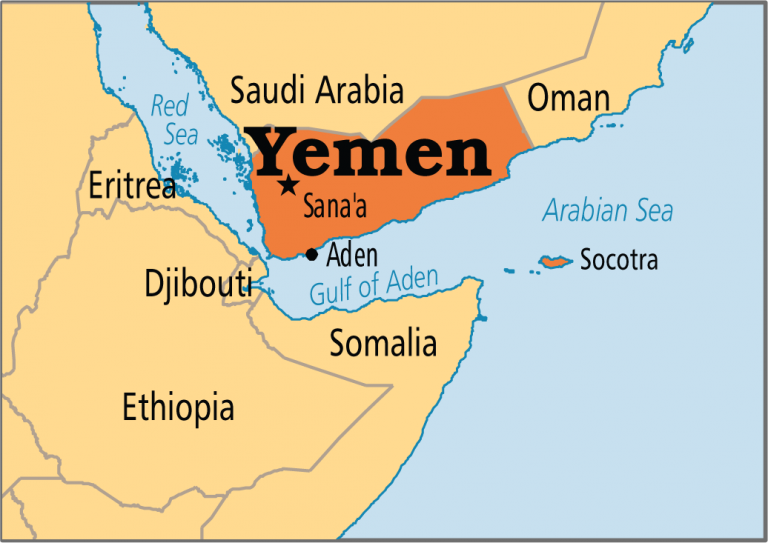After the UAE-backed Southern Transitional Council (STC) seized control of the island of Socotra last June, various claims have emerged over Abu Dhabi’s vision for the island. As it seeks to consolidate its control for its geopolitical aims, its policies are causing clear divisions on the island.

Since the United Arab Emirates-backed separatist Southern Transitional Council (STC) seized control of Yemen’s remote island of Socotra in June and toppled the local authorities, many unverified allegations of the UAE’s activities on the island via its Yemeni client faction have emerged.
Socotra is located around 230 miles from mainland Yemen and 60 miles from the Horn of Africa. Also known as the “Galapagos of the Indian Ocean,” Socotra is a UNESCO Heritage Site: 37 percent of its 825 plant species are endemic to the island. It hosts 11 unique bird species and 90 percent of its reptiles are exclusive to its eco-system. In other words, there is no place like it on earth.

Map highlighting Yemen and its remote island of Socotra
With Abu Dhabi’s lack of transparency over its policies in Socotra, its true objectives may appear difficult to decipher. Emirati media organizations have mostly presented its actions as solely “humanitarian.” However, like elsewhere in the Middle East and North Africa, the UAE has adopted a benevolent smokescreen to conceal its true expansionist objectives.
The UAE has adopted a benevolent smokescreen to conceal its true expansionist objectives.
The separatist STC calls for an independent southern Yemen away from the auspices of Abdrabbuh Mansur Hadi’s government, per pre-1990 unification lines when Yemen was divided into the north and south. And the UAE has entirely propped up and empowered the STC across southern Yemen.
AD

This aids its objectives of controlling south Yemen’s ports, establishing a wider sphere of influence across the Horn of Africa, and bolstering its global maritime trade through the Indian Ocean and Bab el Mandeb. Control of the island would enable Abu Dhabi to build a military base and protect its port infrastructure in southern Yemen and the Horn of Africa, even though this would also erode the island’s natural beauty.
Saudi Arabia and the UAE have previously jostled to control Socotra which they perceive as purely geostrategic. Emirati forces moved into the island in May 2018, to consolidate the STC’s control, sparking criticism from both Socotra’s leadership and the Hadi government. Yemen’s internationally recognized government even complained to the United Nations, thus putting the spotlight on Abu Dhabi.
Though Saudi Arabia subsequently negotiated a partial Emirati drawdown, Abu Dhabi’s forces retained a presence there, with the long-term goal of wresting control of the island.
As pressure on the UAE’s role in Socotra soon waned, last June’s lasting takeover confirms that Abu Dhabi had successfully outmaneuvered Riyadh in their rivalry over Yemen. Saudi Arabia, which had previously opposed the UAE’s occupation efforts, seems to have now accepted it.
The STC’s seizure of Socotra has triggered further tensions, as many residents oppose its attempts to “occupy” the island.
However, the STC’s seizure of Socotra has triggered further tensions, as many residents oppose its attempts to “occupy” the island.
“Locals are continuing to protest the worsening situation while demanding the return of the local government which was forced out after the STC’s takeover,” Fuad Rajeh, an independent Yemeni researcher, told Inside Arabia. “Socotra is divided, and this is not good for an archipelago which used to be stable and peaceful.”

Regional map showing Yemen and its area of conflict
The STC in early November reportedly established an office on the island where northern Yemenis coming from outside the island must register as “foreigners.” A source cited by the Anadolu News Agency in the Middle East Monitor said that “the office records the data of Yemenis who come from outside Socotra, grant them work permits on the island, and treat them as foreigners despite their Yemeni nationality.”
This follows numerous attempts from the STC to expel northerners from south Yemen, particularly Aden. Evidently, this discrimination and regionalism from the STC is part of the movement’s aims to establish a northern Yemen state, where southerners receive a distinct national identity from northerners.
The STC in October arrested Dr. Ahmed Salaam al-Amiri, a professor at Socotra island’s College of Education, for publishing an opinion piece on the situation in the island, according to the Geneva-based human rights organization SAM.
SAM’s report also claims that many STC opponents were fired from their jobs and activists were arrested. Another recent case it highlighted on November 2 was Riyadh Saeed Suleiman, Director of the Socotra port. Suleiman was reportedly imprisoned, and STC police forces ordered him to call his brother to hand over his job stamp and threatened to keep him detained should he refuse.
Local residents claimed that STC militias fired live bullets against protestors, added Rajeh.
The STC apparently seeks to crush opposition towards its control of the island, and ultimately deliver the UAE’s own projects for Socotra.
On September 7, lawmakers of Yemen’s al Islah Party (or the Yemeni Congregation for Reform) and other independent lawmakers warned Yemen’s Prime Minister Maeen Abdulmalik Saeed that the UAE was building two military camps in Socotra, and that it already established a military base there. The lawmakers also alleged that Emirati military officials had traveled to Socotra and built eight transmitter towers.
“The UAE troops are now controlling Socotra’s seaport, airport, and the sea amid reports UAE companies are fishing without permission from the government.”
“The UAE troops are now controlling Socotra’s seaport, airport, and the sea amid reports UAE companies are fishing without permission from the government, or rather stealing Yemeni fish,” Rajeh told Inside Arabia.
Socotran tribal leader Issa Salem bin Yaqut claimed in a statement in September that the UAE and Saudi Arabia let Israel into the island, and accused Abu Dhabi and Riyadh of “destroying the charming and rare environmental landmarks on Socotra Island and establishing camps amid a terrible international silence.”
This followed allegations that the UAE and Israel that month established a spy base together in Socotra, after their normalization of relations. While it is too premature to suggest significant cooperation between Abu Dhabi and Tel Aviv over Yemen, future cooperation over Yemen could be likely, since normalization enables both governments to tighten their regional cooperation.
After all, the UAE has searched elsewhere for external support to recognize its control over Socotra. In June, Somalia Today reported that Abu Dhabi offered to re-open its Sheikh Zayed Hospital in Mogadishu, which it closed two years ago after their relations soured. Yet this humanitarian gesture was in exchange for Somalia recognizing the UAE’s control over Socotra island. Mogadishu rejected Abu Dhabi’s invitation.
Abu Dhabi may ultimately seek to fully annex Socotra, although that would require global recognition of the STC’s control over the island and south Yemen. Nonetheless, a continued lack of external pressure could still allow the UAE to slowly embed itself in Socotra via the STC, even without international recognition.
And despite claims that Joe Biden will be tougher on Gulf states such as the UAE, Biden had shown little desire to curtail Abu Dhabi’s regional activities, compared to his criticism of Saudi Arabia during his presidential campaign. This would ultimately prolong Washington’s tolerance of Abu Dhabi’s foreign policy actions.
And since Socotra is not a priority for the international community, the UAE may gradually edge further towards cementing its control of the island in the future.
Inside Arabia

